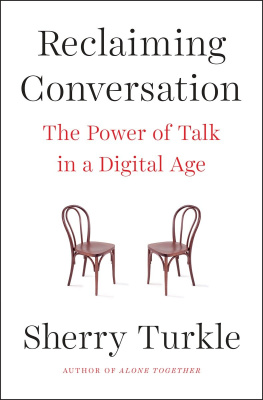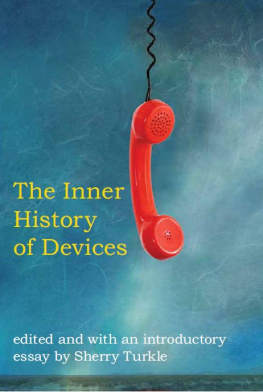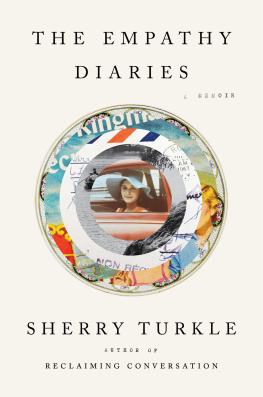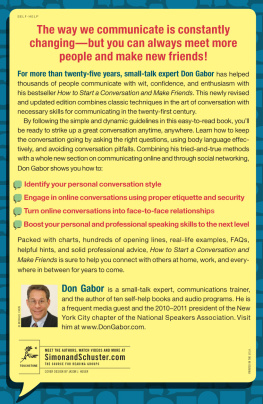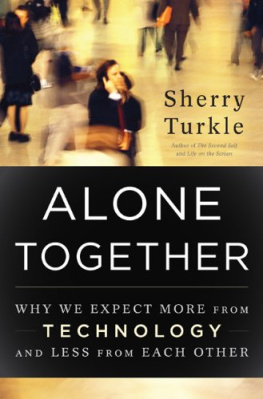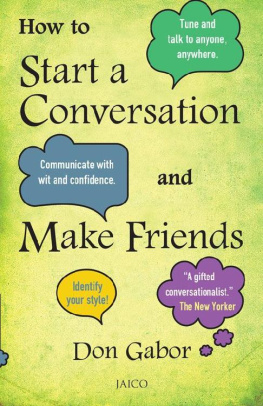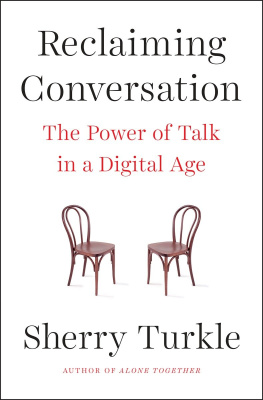I had three chairs in my house; one for solitude, two for friendship, three for society.
We had talk enough, but no conversation.
The Empathy Diaries
Twelve-year-olds play on the playground like eight-year-olds.... They dont seem able to put themselves in the place of other children.
THE DEAN OF THE HOLBROOKE MIDDLE SCHOOL, COMMENTING ON AN EMPATHY GAP AMONG STUDENTS
W hy a book on conversation? Were talking all the time. We text and post and chat. We may even begin to feel more at home in the world of our screens. Among family and friends, among colleagues and lovers, we turn to our phones instead of each other. We readily admit we would rather send an electronic message or mail than commit to a face-to-face meeting or a telephone call.
This new mediated life has gotten us into trouble. Face-to-face conversation is the most humanand humanizingthing we do. Fully present to one another, we learn to listen. Its where we develop the capacity for empathy. Its where we experience the joy of being heard, of being understood. And conversation advances self-reflection, the conversations with ourselves that are the cornerstone of early development and continue throughout life.
But these days we find ways around conversation. We hide from each other even as were constantly connected to each other. For on our screens, we are tempted to present ourselves as we would like to be. Of course, performance is part of any meeting, anywhere, but online and at our leisure, it is easy to compose, edit, and improve as we revise.
We say we turn to our phones when were bored. And . It means maintaining eye contact while texting. My students tell me they do it all the time and that its not that hard.
We begin to think of ourselves as a tribe of one, loyal to our own party. We check our messages during a quiet moment or when the pull of the online world simply feels irresistible. Even children text each other rather than talk face-to-face with friendsor, for that matter, rather than daydream, where they can take time alone with their thoughts.
It all adds up to a flight from conversationat least from conversation that is open-ended and spontaneous, conversation in which we play with ideas, in which we allow ourselves to be fully present and vulnerable. Yet these are the conversations where empathy and intimacy flourish and social action gains strength. These are the conversations in which the creative collaborations of education and business thrive.
But these conversations require time and space, and we say were too busy. Distracted at our dinner tables and living rooms, at our business meetings, and on our streets, inhibits conversations that matter. The very sight of a phone on the landscape leaves us feeling less connected to each other, less invested in each other.
Despite the seriousness of our moment, I write with optimism. Once aware, we can begin to rethink our practices. When we do, conversation is there to reclaim. For the failing connections of our digital world, it is the talking cure.
They Make Acquaintances, but Their Connections Seem Superficial
I n December 2013, I was contacted by the dean of the Holbrooke School, a middle school in upstate New York. I was asked to consult with its faculty about what they saw as a disturbance in their students friendship patterns. In her invitation, the dean put it this way: Students dont seem to be making friendships as before. They make acquaintances, but their connections seem superficial.
The case of the superficial acquaintances in middle school was compelling. It was of a piece with what I was hearing in other schools, about older students. And so it was decided that I would join the Holbrooke teachers on a faculty retreat. I brought along a new notebook; after an hour, I wrote on its cover The Empathy Diaries.
For thats what the Holbrooke teachers are thinking about. Children at Holbrooke are not developing empathy in the way that years of teaching suggested they would. Ava Reade, the dean of the school, says that she rarely intervenes in student social arrangements, but recently she had to. A seventh grader tried to exclude a classmate from a school social event. Reade called the remiss seventh grader into her office and asked why it happened. The girl didnt have much to say:
[The seventh grader] was almost robotic in her response. She said, I dont have feelings about this. She couldnt read the signals that the other student was hurt.
These kids arent cruel. But they are not emotionally developed. Twelve-year-olds play on the playground like eight-year-olds. The way they exclude one another is the way eight-year-olds would play. They dont seem able to put themselves in the place of other children. They say to other students: You cant play with us.
They are not developing that way of relating where they listen and learn how to look at each other and hear each other.
The Holbrooke teachers are enthusiastic users of educational technology. But on their retreat, they follow what some call : Indication of harm, not proof of harm, is our call to action. These teachers believe they see indications of harm. It is a struggle to get children to talk to each other in class, to directly address each other. It is a struggle to get them to meet with faculty. And one teacher observes: The [students] sit in the dining hall and look at their phones. When they share things together, what they are sharing is what is on their phones. Is this the new conversation? If so, it is not doing the work of the old conversation. As these teachers see it, the old conversation taught empathy. These students seem to understand each other less.
I was invited to Holbrooke because for many decades I have studied childrens development in technological culture. I began in the late 1970s, when a few schools were experimenting with personal computers in classrooms or special computer laboratories. I work on this question still, when many children come to school with a tablet or laptop of their own, or one their school has issued.

